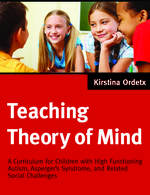 Dr. Kirstina Ordetx is the founder of Pinnacle Academy, an alternative private school for children with autism spectrum disorders in Bradenton, Florida, USA, and CEO of the Center for Autism Resources and Education, a not-for-profit organization which supports families and professionals working with children with ASD in Southwest Florida. She is also Director of Developmental Behavior Services at Advanced ABA, an organization which provides theory of mind and social skills training for ASD children.
Dr. Kirstina Ordetx is the founder of Pinnacle Academy, an alternative private school for children with autism spectrum disorders in Bradenton, Florida, USA, and CEO of the Center for Autism Resources and Education, a not-for-profit organization which supports families and professionals working with children with ASD in Southwest Florida. She is also Director of Developmental Behavior Services at Advanced ABA, an organization which provides theory of mind and social skills training for ASD children.
In this interview, she discusses her new book for teachers and other education professionals, Teaching Theory of Mind, including her inspiration behind the programme and what makes it so successful.
Can you tell us a little bit about you and how you came to work with children with ASD? What led you to form Pinnacle Academy?
Nearly 20 years ago, I worked with a child who had been diagnosed with autism. His behavior was severe and significantly impacted his and his family’s quality of life. Through intensive, daily therapy, we were able to habilitate him and transition him into a regular kindergarten classroom. The experience was life-changing for me, personally. Over the years, my understanding of this condition and compassion for these families continues to evolve. I learn something new each day.
Pinnacle Academy was started by me and a parent ten years ago, in an effort to provide a specialized educational setting for children. Today, the Academy is “home” to over 100 students and provides treatment and education for children at any point on the spectrum. The families and faculty inspire me to continue to grow and to spread information to others who share my vision.
Why is theory of mind a particular area of difficulty for children with ASD?
For individuals who have Asperger’s syndrome and “high-functioning” autism, I believe that the Theory of Mind (ToM) concept defines the very breakdown in their social relationships. The first book I read regarding ToM was Simon Baron-Cohen’s Mindblindness. His writings spoke to me, opened my mind to a new explanation, and answered so many questions that I had been struggling with. When I assign this book to parents, they unanimously say: “That’s it! That’s my child!” It is so exhilarating to understand the core issue and apply strategies that work. As Michelle Garcia-Winner explains in her works, the breakdown is in social thinking. Hopefully, more professionals will embrace the curriculum that is now available.
 How can the book and the program help?
How can the book and the program help?
I created this curriculum primarily for children who need a very basic foundation in the development of Theory of Mind. It often takes several sessions before participants even recognize that they are in the program to create change in themselves. The effects of the program can be profound. The caregiver education component is essential throughout the 12-week curriculum and assists in the generalization of learned skills. This program also lays a foundation so that children may continue cultivating their ToM skills via other well-respected curriculum that is available.
How has your background in Cognitive Behavioral Therapy (CBT) and Applied Behavioral Analysis influenced the program?
CBT has always been a focus of my eclectic treatment model. The use of interactive lessons, self-assessment, video modelling, homework assignments, review, and goal setting strategies empower the children to be active participants. The focus of the program is on changing behavior and cognition. The combination is a recipe for success.
You’ve used the program with hundreds of children now, with some really positive results. What makes it so successful?
This program was developed to address the very basics in Theory of Mind development. It is for children who have difficulty grasping the rules and nuances of social interactions. The Social Experience was a name given to the program, because of the many caregivers who express to me that their child is simply “missing out on the entire social experience”. Furthermore, I had found that many of my clients were not fully ready to benefit from some of the other curricula that are available. I have seen this program provide children with a strong, basic foundation so that they may actively participate in those resources, which are listed in the book. In addition, the book has been designed to provide a step-by-step teaching manual, so that a variety of caregivers may instruct children in a small or large group setting.
Can you tell us about your most memorable ‘success story’?
Every child’s progress is a success story, regardless of whether it is large or small. When a child is able to engage in self-assessment and self-regulation to perform social problem solving skills, I consider that a success. There have been specific situations, particularly during video modelling exercises, where a child will have an “ah-ha” moment – the first time he actually realizes that his behavior contributes to a breakdown in social communication. This, of course, is my favorite moment, because active participation can now occur. Of course, it is always encouraging to have children return to ToM class each week and share stories of how their new “tools” worked.
You talk a lot in the book about the importance of reinforcing skills learned in different environments. What role can parents and caregivers play in this?
This is a skill-building program. Each curricular activity is designed to highlight a specific skill, and is followed by homework assignments and a caregiver letter to support discussion and growth outside of the class. Caregivers are first-responders to the child’s daily review of accomplishments and challenges. They can only support the child’s development when they have strategies and language to enhance their skill set. Skill rehearsal outside of the ToM classes will lead to improved troubleshooting skills, increased self-awareness, and an imperative generalization of skills across setting and social partners.
Copyright © Jessica Kingsley Publishers 2012.